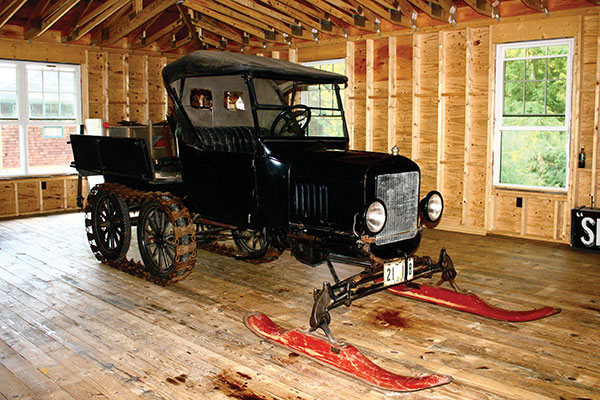Model Ts were a natural for these conversions because of their sheer simplicity — and massive numbers on the road
Virgil D. White was a clever inventor who sold and serviced Model T Fords, becoming an authorized Ford dealer in West Ossipee, NH. By 1913, he had patented a snowmobile conversion kit for Model T Fords, which he sold for $400, and complete vehicles were sold for $750. 1923 seems to be the first year that he actively marketed the newlyinvented “snowmobile.” The first year, they sold only 75. Once people saw them in action, sales quickly jumped to as many as 2,500 per year. Typical snowmobile customers were doctors and rural mail carriers.
The 1923 Model T Ford Snowmobile offered here is one of 75 completed units sold in this first year of production. It was sold by the Authorized Ford Agency of George H. Chesley in Dover, NH. There is a die-cast plate mounted on this snowmobile’s dashboard that was put on when new. One of the White’s Garage advertising slogans was “MAKES THE SNOWTRAIL A BOULEVARD.”
This example is considered by both the Model T Ford and snowmobile experts to be the best preserved, most original example of its type. The paint, top and interior are believed to be original and untouched. The seat cushion shows wear, but the rest of the vehicle is remarkably well-preserved and extremely presentable. Both stock wheels (for dry roads and weather) as well as proper original skis and original metal tracks (for snow and ice) are being sold with it. Both the skis and the metal tracks show very little wear, leading us to believe that the vehicle has seen very little use. Included are an excellent pair of snow tracks and front skis.
The Magee Collection purchased this vehicle from the original owner’s family, still living in Franklin, NH, in the 1990s. It was last used in the snow several years ago but has recently been serviced and reportedly runs superbly. Although other firms also made snowmobile conversions for early Fords, the “White’s Garage” examples are generally believed to be of the highest quality.

